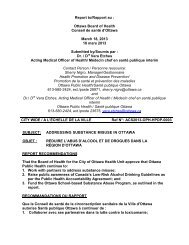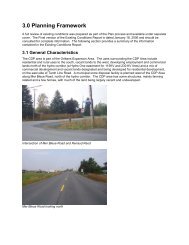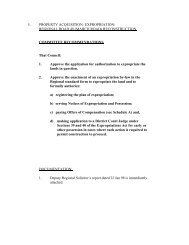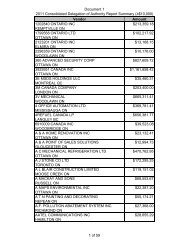Audit of Five Specific Staffing Processes - City of Ottawa
Audit of Five Specific Staffing Processes - City of Ottawa
Audit of Five Specific Staffing Processes - City of Ottawa
You also want an ePaper? Increase the reach of your titles
YUMPU automatically turns print PDFs into web optimized ePapers that Google loves.
<strong>Audit</strong> <strong>of</strong> <strong>Five</strong> <strong>Specific</strong> <strong>Staffing</strong> <strong>Processes</strong><br />
Job descriptions are the common basis for classification, staffing and compensation.<br />
It is therefore critical that all disciplines respect the basic requirements outlined in<br />
the job description in order to equitably pay the candidate who possesses the skills<br />
outlined as a basic requirement in the job description, given that these are the same<br />
basic requirements that were used to evaluate the job and determine the rate <strong>of</strong> pay.<br />
For these reasons, the classification process calls for “minimal” education and<br />
experience on job descriptions. Hiring managers may, in some cases, “exaggerate”<br />
the “minimal requirements” for classification purposes in order to obtain the<br />
highest grade and ultimate pay band for their positions, yet they are prepared to<br />
interview and select candidates who do not meet those same requirements. In some<br />
cases, equivalencies make good sense as long as they are clearly articulated and<br />
applied. However, one can argue that not respecting the guidelines can ultimately<br />
result in having employees that are paid for education and experience that they<br />
simply don’t have. The <strong>City</strong> provides very good paying jobs with great benefits and<br />
as a result should be able to attract the best qualified candidates from within the<br />
<strong>City</strong> and if not, then from the labour market to achieve its goals and value for<br />
money.<br />
In this case, the <strong>City</strong> provided the opportunity to an employee to compete who did<br />
not meet the strict requirements <strong>of</strong> the position. The employee was allowed to<br />
compete on the basis <strong>of</strong> an interpretation <strong>of</strong> “equivalencies” and the fact that the<br />
applicant was known to the hiring manager. Management indicated this practice is<br />
particularly prevalent and occurs regularly in high turnover areas. Such actions<br />
undermine the principle <strong>of</strong> fairness and integrity and raise concerns <strong>of</strong> preferential<br />
treatment where there is no level playing field, particularly when familial ties exist.<br />
It was inappropriate for the hiring manager to provide an opportunity to someone<br />
who did not meet the minimal education and experience as outlined in the<br />
competition poster. This candidate was ultimately successful in the competition<br />
and received the highest mark, which in itself appears to defy logic or shows a low<br />
correlation between the requirements <strong>of</strong> the position and the tests administered.<br />
Finally, the competition screening summary was provided to HR only after the<br />
interview and selection process was fully completed. It should have been provided<br />
at the outset with comments and rationale for inclusion or exclusion <strong>of</strong> candidates<br />
to allow HR to fulfill its oversight and compliance role. Some rationale is required<br />
to justify any discrepancies between HR and the hiring managers on “screening in”<br />
or “screening out” <strong>of</strong> candidates. Inasmuch as it is the hiring manager’s<br />
determination in the end, there should be a rationale to justify the actions and<br />
ultimate decisions. A similar recommendation was previously included in a 2006<br />
the <strong>Audit</strong> <strong>of</strong> the <strong>Staffing</strong> Process for xxxxxxxxxxxxxxxxxxxxx xxxxxx and agreed to<br />
by management (Reference Recommendations 3 and 4).<br />
Office <strong>of</strong> the <strong>Audit</strong>or General 2009 Annual Report Page 5









